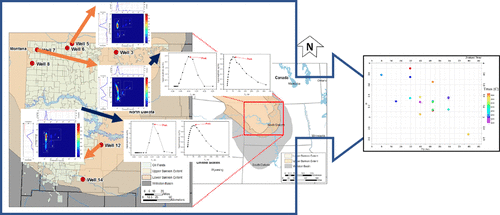当前位置:
X-MOL 学术
›
Energy Fuels
›
论文详情
Our official English website, www.x-mol.net, welcomes your
feedback! (Note: you will need to create a separate account there.)
Experimental Investigation of Solid Organic Matter with a 2D NMR T1–T2 Map
Energy & Fuels ( IF 5.2 ) Pub Date : 2021-09-16 , DOI: 10.1021/acs.energyfuels.1c02449 Kouqi Liu 1 , Thomas Gentzis 2 , Humberto Carvajal-Ortiz 2 , Zonghai Harry Xie 2 , Mehdi Ostadhassan 3
Energy & Fuels ( IF 5.2 ) Pub Date : 2021-09-16 , DOI: 10.1021/acs.energyfuels.1c02449 Kouqi Liu 1 , Thomas Gentzis 2 , Humberto Carvajal-Ortiz 2 , Zonghai Harry Xie 2 , Mehdi Ostadhassan 3
Affiliation

|
Organic matter (OM), as the source of the hydrocarbon in shale plays, should be studied extensively from various perspectives. In this regard, using a 2D NMR T1–T2 map is becoming a popular method that can be used to distinguish proton populations of different sources, including the OM in shale samples. In this study, 17 shale samples with different maturities from the Bakken Formation in the United States were collected and analyzed by using the 2D NMR T1–T2 map method to assess the physicochemical properties of the OM. The results showed that the OM in these samples belongs to kerogen type II and is in the immature to early oil generation window stages. While the 2D NMR T1–T2 maps were separated into four different regions representing different sources of protons, the focus of the study was only on the signal for region 2 that is indicative of the solid OM. Based on detailed analysis of the spectrum from this region, two new parameters named T1p and T2p, respectively, representing the peak of the T1 and T2 relaxation time distributions, were proposed. The detailed analysis demonstrated that T2P did not vary much with maturity, while the T1P value increased as thermal maturity advanced. This resulted in an overall increase of the T1P/T2P ratio versus thermal maturity. T1 relaxation time distribution more clearly exhibits the effect of thermal maturity on OM compared to T2 relaxation time distribution in region 2. Finally, the fractal analysis of the T1 relaxation time spectrum truncated of region 2 showed that as the maturity increased, the fractal dimension declined, which suggests that the T1 relaxation time attributes a more chemically homogeneous structure to the OM.
中文翻译:

使用 2D NMR T1-T2 图对固体有机物进行实验研究
有机质(OM)作为页岩区油气的来源,应从多方面进行广泛研究。在这方面,使用 2D NMR T 1 – T 2图正在成为一种流行的方法,可用于区分不同来源的质子种群,包括页岩样品中的 OM。本研究采集了美国巴肯组17个不同成熟度的页岩样品,采用二维核磁共振T 1 - T 2图方法对OM的理化性质进行了分析。结果表明,这些样品中的OM属于干酪根类型II,处于未成熟到早期生油窗口阶段。而二维核磁共振T 1 – T 2图被分成四个不同的区域,代表不同的质子来源,研究的重点仅放在区域 2 的信号上,该信号指示固体 OM。基于对该区域光谱的详细分析,提出了两个新参数T 1p和T 2p,分别代表T 1和T 2弛豫时间分布的峰值。详细分析表明,T 2P随成熟度变化不大,而T 1P值随着热成熟度的提高而增加。这导致T 1P / T 2P比率与热成熟度的整体增加。与区域 2 中的T 2弛豫时间分布相比,T 1弛豫时间分布更清楚地展示了热成熟度对 OM 的影响。最后,对区域 2 截断的T 1弛豫时间谱的分形分析表明,随着成熟度的增加,分形维数下降,这表明T 1弛豫时间将化学上更均匀的结构归因于 OM。
更新日期:2021-10-07
中文翻译:

使用 2D NMR T1-T2 图对固体有机物进行实验研究
有机质(OM)作为页岩区油气的来源,应从多方面进行广泛研究。在这方面,使用 2D NMR T 1 – T 2图正在成为一种流行的方法,可用于区分不同来源的质子种群,包括页岩样品中的 OM。本研究采集了美国巴肯组17个不同成熟度的页岩样品,采用二维核磁共振T 1 - T 2图方法对OM的理化性质进行了分析。结果表明,这些样品中的OM属于干酪根类型II,处于未成熟到早期生油窗口阶段。而二维核磁共振T 1 – T 2图被分成四个不同的区域,代表不同的质子来源,研究的重点仅放在区域 2 的信号上,该信号指示固体 OM。基于对该区域光谱的详细分析,提出了两个新参数T 1p和T 2p,分别代表T 1和T 2弛豫时间分布的峰值。详细分析表明,T 2P随成熟度变化不大,而T 1P值随着热成熟度的提高而增加。这导致T 1P / T 2P比率与热成熟度的整体增加。与区域 2 中的T 2弛豫时间分布相比,T 1弛豫时间分布更清楚地展示了热成熟度对 OM 的影响。最后,对区域 2 截断的T 1弛豫时间谱的分形分析表明,随着成熟度的增加,分形维数下降,这表明T 1弛豫时间将化学上更均匀的结构归因于 OM。











































 京公网安备 11010802027423号
京公网安备 11010802027423号